Events
Events
Current & Upcoming Events
EAI x Luhring Augustine Gallery: An Evening with Charles Atlas
Electronic Arts Intermix (EAI)
264 Canal St #3W
New York, NY 10013
April 25th, 2025
7:00 pm ET
RSVP here. Seating is first come, first serve. RSVP does not guarantee entry, but helps us track interest and send event updates and reminders.
EAI and Luhring Augustine are pleased to celebrate Charles Atlas, an exceptional figure whose innovations with video as an artistic medium span five decades of technological evolution and collaboration. Atlas will appear in-person for the event, in conversation with EAI's Executive Director, Rebecca Cleman, and Distribution Director, Karl McCool.
Atlas will guide the audience through excerpts of his blue and green screen works, which showcase Atlas's rich array of collaborators—including Merce Cunningham, Douglas Dunn, Bill Irwin, Anohni, and Sonic Youth—and his early experiments in video production techniques. As filmmaker-in-residence for the Merce Cunningham Dance Company, Atlas developed the “videodance” genre, in which the camera, moving dynamically with the dancers, becomes an integral part of a dance rather than an objective, fixed-perspective recorder. Atlas draws from his distinctive sensibility as a cineaste to amplify his subject’s movements with inventive video effects, including doubling, image overlay, and striking compositions within the frame.
Atlas began using blue stage backdrops in the mid-1970s as an early experiment in chroma key compositing (often called “green screening”) to situate his performers’ movement within fantastical, colorful, and dynamic video scenes. The first of these experiments, Blue Studio: Five Segments (1975-76), a collaboration with Cunningham, was produced using high-end equipment at the TV Lab of WNET on the invitation of Nam June Paik. Cunningham’s body is multiplied, manipulated, and superimposed onto eclectic backdrops as he performs five short pieces made for the camera.
After WNET, television remained a fruitful context to explore televisual aesthetics and production tropes as Atlas continued to develop projects with other collaborators. Broadcast on PBS, As Seen on TV (1987), in collaboration with Bill Irwin, captures the bumbling antics of a vaudevillian performer (Irwin) who becomes stuck in a television during an audition and left as a bystander across various scenes as the channels change. The Myth of Modern Dance (1990), commissioned by WGBH and in collaboration with choreographer Douglas Dunn, satirizes shared assumptions of linear progress in both evolutionary theory and dance history. Divided into short episodic performances, the video is a distinct example of Atlas’s maximalist aesthetics produced through visual juxtaposition, nonlinear narratives, and collaged soundtracks.
Documentary was another form through which Atlas honed his unique production style. Put Blood in the Music (1989) first aired on the UK television program The South Bank Show and captures the distinct energy of New York City’s downtown music scene. Restructuring the traditional “talking head” documentary, Atlas employs green screen effects to superimpose interviews with musical mainstays, including John Zorn and Sonic Youth, over discordant footage of the city’s streets.
Preceding the conversation, EAI will screen an episode from The Martha Tapes (1996-2000), Atlas's series featuring found footage of dance performance, interrupted by irreverent callouts to famous "Marthas" in Hollywood cinema. The Martha Tapes screened at Richard Move's monthly variety show at the nightclub Mother, in New York’s Meatpacking district, and exemplify the intrinsic relationship between Atlas’s video work and New York's queer nightlife and performance scenes. These tapes demonstrate Atlas’s capacious appetite for cinema and television, and his singular ability to process what he ingests into new forms that are at once distinctly humorous and haunting.
Electronic Arts Intermix (EAI)’s venue is located at 264 Canal Street, 3W, near several Canal Street subway stations. Our floor is accessible by elevator (63" × 60" car, 31" door) and stairway. Due to the age and other characteristics of the building, our bathrooms are not ADA-accessible, though several such bathrooms are located nearby. If you have questions about access, please contact cstrange@eai.org in advance of the event.
